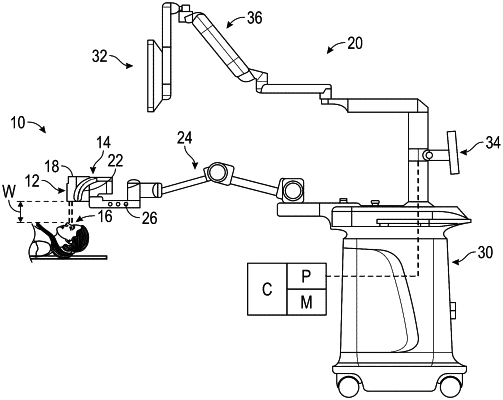| CPC A61B 3/102 (2013.01) [A61B 3/08 (2013.01); A61B 3/107 (2013.01); A61F 9/00736 (2013.01); A61F 9/00834 (2013.01); A61F 2009/00846 (2013.01); A61F 2009/00851 (2013.01); A61F 2009/00855 (2013.01)] | 20 Claims |

|
1. A system for guiding an ophthalmic procedure, the system comprising:
a housing assembly having a head unit configured to be at least partially directed towards a target site in an eye;
an optical coherence tomography (OCT) module at least partially located in the head unit and configured to obtain a first set of volumetric data of the target site;
a stereoscopic visualization camera at least partially located in the head unit and configured to obtain a second set of volumetric data of the target site, the second set of volumetric data including first and second views of the target site;
a controller in communication with the stereoscopic visualization camera and the OCT module;
a volumetric render module selectively executable by the controller;
wherein the controller has a processor and tangible, non-transitory memory on which instructions are recorded, execution of the instructions causing the controller to:
register the first set of volumetric data from the OCT module with the second set of volumetric data from the stereoscopic visualization camera to create a third set of registered volumetric data;
render the third set of registered volumetric data to a first region to obtain a two-dimensional OCT view, via the volumetric render module;
render the second set of volumetric data from the stereoscopic visualization camera to a second region to obtain a live two-dimensional stereoscopic view, via the volumetric render module;
obtain a plurality of depth scans extending through a corneal surface, each of the plurality of depth scans defining respective starting points;
collect respective three-dimensional locations corresponding to the respective starting points of the plurality of depth scans as a point cloud, and convert the point cloud to obtain an extracted curvature, including interpolating between the respective starting points; and
overlay the first region and the second region to obtain a shared composite view of the target site and at least one of visualize and extract features of the target site.
|